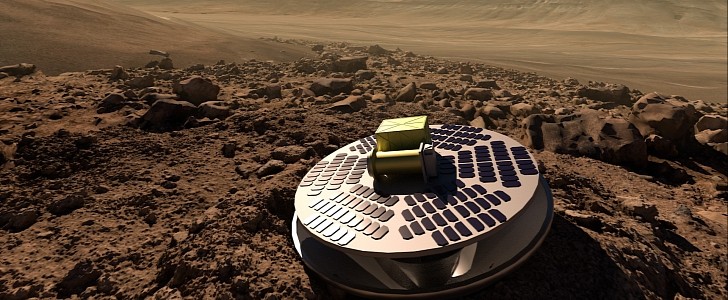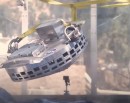NASA has been hard at work designing a new lander that can withstand a powerful impact. The space agency has so far tested a full-scale prototype of the lander's base, slamming it to the ground at incredible speeds. If all goes as planned, the lander might one day allow low-cost missions to land on Mars and also expand the possibilities for landing locations.
The lander concept, called Simplified High Impact Energy Landing Device, or SHIELD, has an innovative design with a base that should absorb the impact of a hard landing. NASA has landed on Mars nine times so far, and each time it utilized parachutes, jetpacks, and giant airbags to slow down the spacecraft and guarantee a safe touchdown.
But SHIELD's design would be much more cost-effective, and it would also allow NASA to explore locations that are difficult to access. The lander concept includes a collapsible base created to absorb the impact of a hard landing, acting just like the crumple zone of a car.
To test this innovative design, engineers from NASA's Jet Propulsion Laboratory (JPL) hurled a SHIELD prototype to the ground at the speed of a Mars landing. The team wanted to see if the concept could protect sensitive cargo, just like the sample tubes collected by the Perseverance rover that are set to be returned to Earth on a future mission.
So they used a drop tower at JPL to re-recreate the forces that SHIELD would encounter. The drop tower, which is about 90 ft tall (27 meters), has a massive sling that can hurl an object into the ground at impressive speeds. On August 12th, SHIELD was slammed into the ground at 110 mph (177 kph), which is the speed reached by a lander that arrives near the Martian surface after it gets slowed down by atmospheric drag.
A dirt "landing zone" was used in previous tests. However, for this particular test, a steel plate was placed on the ground to guarantee that the impact was even more intense than what a spacecraft would encounter on Mars. Several electrical components, including a smartphone hidden inside the SHIELD prototype, survived the collision. You can watch the lander concept hit the ground in the video attached down below.
But SHIELD's design would be much more cost-effective, and it would also allow NASA to explore locations that are difficult to access. The lander concept includes a collapsible base created to absorb the impact of a hard landing, acting just like the crumple zone of a car.
To test this innovative design, engineers from NASA's Jet Propulsion Laboratory (JPL) hurled a SHIELD prototype to the ground at the speed of a Mars landing. The team wanted to see if the concept could protect sensitive cargo, just like the sample tubes collected by the Perseverance rover that are set to be returned to Earth on a future mission.
So they used a drop tower at JPL to re-recreate the forces that SHIELD would encounter. The drop tower, which is about 90 ft tall (27 meters), has a massive sling that can hurl an object into the ground at impressive speeds. On August 12th, SHIELD was slammed into the ground at 110 mph (177 kph), which is the speed reached by a lander that arrives near the Martian surface after it gets slowed down by atmospheric drag.
A dirt "landing zone" was used in previous tests. However, for this particular test, a steel plate was placed on the ground to guarantee that the impact was even more intense than what a spacecraft would encounter on Mars. Several electrical components, including a smartphone hidden inside the SHIELD prototype, survived the collision. You can watch the lander concept hit the ground in the video attached down below.







